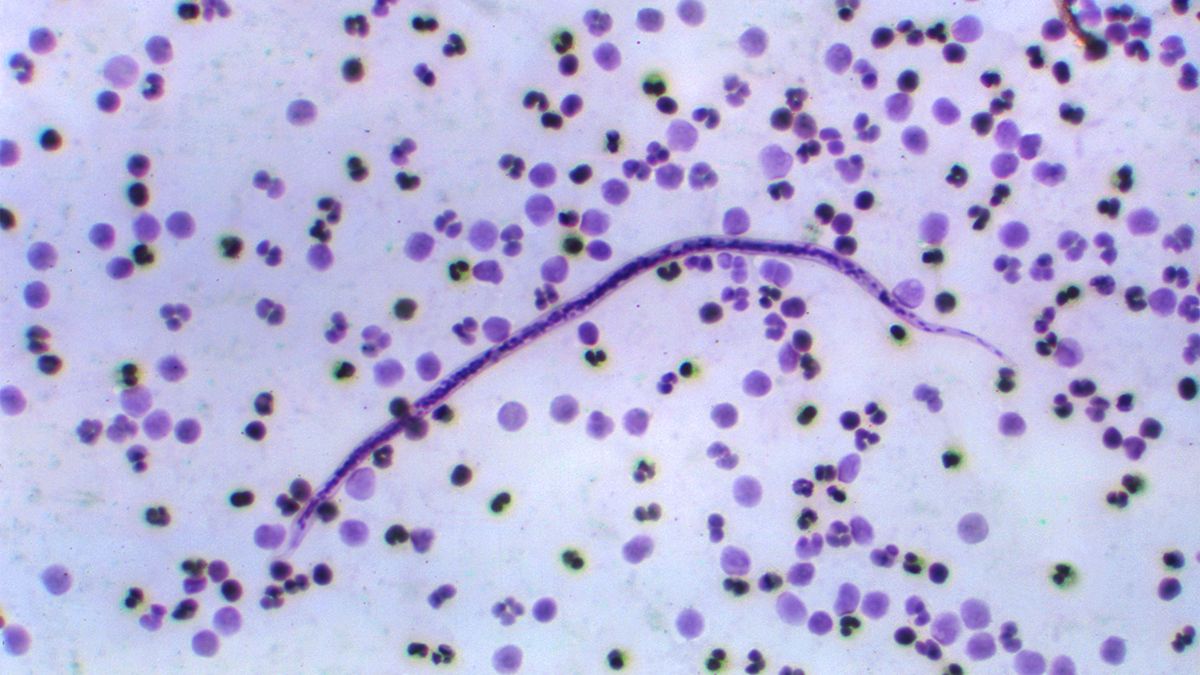What to know
The treatment of loiasis is complex and is best undertaken after consultation with experts who have experience in the treatment of the disease and prevention of complications of treatment. Additionally, there may be times when it is best not to treat the infection.

Medications
The drug of choice for the treatment of loiasis is diethylcarbamazine (DEC). Most patients will achieve cure, defined as resolution of symptoms, resolution of eosinophilia, and decreasing antifilarial antibody titers, with one or two courses of DEC. Some will require additional courses of DEC or a trial of albendazole. DEC is the treatment of choice because there is solid evidence that it kills both the microfilariae and the adult worms, resulting in quicker resolution of the infection. The risk of fatal encephalopathy or other severe adverse neurologic events is related to the microfilarial load. Quantitative blood smears are required before initiating treatment (see notes below). Prophylactic DEC (300 mg once a week) can be used to prevent infection in long-term travelers to endemic areas.
There is some evidence that albendazole given twice daily for 21 days may be an effective treatment for loiasis that is refractory to DEC treatment. It also may be used to reduce microfilarial load prior to initiation of DEC treatment. The response to albendazole is slow so close, frequent monitoring would be needed to determine when it is safe to treat with DEC. Albendazole does not appear to be prone to cause encephalopathy, though published data are limited.
Treatment of loiasis with antiparasitic agents may result in a brief increase of symptoms, such as Calabar swelling or pruritus. Some authors suggest that these symptoms might be attenuated with the concomitant use of antihistamines or corticosteroids during the first seven days of treatment. There is also the risk of fatal encephalopathy with DEC treatment; this risk has not been shown to be eliminated by corticosteroid treatment. More details on this are given below the treatment table.
Loa loa do not contain Wolbachia, so doxycycline is not an effective treatment.
|
Medication |
Indication |
Adult Dose |
Pediatric Dose |
| Diethylcarbamazine (DEC) | Symptomatic loiasis with MF/mL <8,000 | 8–10 mg/kg/day orally in 3 divided doses daily for 21 days | 8–10 mg/kg/day orally in 3 divided doses daily for 21 days |
| Albendazole | Symptomatic loiasis, with MF/mL <8,000 and failed 2 rounds DEC OR Symptomatic loiasis, with MF/ml ≥8,000 to reduce level to <8,000 prior to treatment with DEC |
200 mg orally twice daily for 21 days | 200 mg orally twice daily for 21 days |
| Apheresis* followed by DEC | Symptomatic loiasis, with MF/mL ≥8,000 | N/A | N/A |
MF = microfilariae of L. loa
*Apheresis should be performed at an institution with experience in using this therapeutic modality for loiasis. Oral albendazole is available for human use in the United States.
Note on risk of fatal encephalopathy when treating loiasis
Available data demonstrate that the risk of fatal encephalopathy in patients treated with DEC with microfilarial loads <8,000 microfilariae per mL approaches zero. In those patients with microfilarial loads ≥8,000 microfilariae per mL, apheresis can be used in specialized centers to reduce the load below the 8,000 threshold prior to beginning treatment. Some authors suggest a more conservative threshold of 2,500 microfilariae per mL for the initiation of treatment of loaisis. This lower threshold would need to be balanced with the risk associated with apheresis. There are some data available that suggest treating the patient with albendazole, 200mg twice daily for 21 days, may reduce the microfilarial load to acceptable levels. Re-measurement of levels after albendazole treatment would be required prior to treatment with DEC.
Treatment in patients with O. vovulus co-infection
Note on obtaining the medication
Diethylcarbamazine (DEC) has been used worldwide for more than 50 years. Because this infection is rare in the United States, the drug is no longer approved by the U.S. Food and Drug Administration (FDA) and cannot be sold in the United States. Physicians can obtain the medication from CDC after confirmed positive lab results.
For questions regarding diagnostic or treatment considerations, contact the Division of Parasitic Diseases and Malaria: parasites@cdc.gov. Diagnostic assistance is also available via DPDx.
Care precautions
Albendazole
Treatment in Pregnancy
Albendazole is a pregnancy category C drug. There are limited data on the use of albendazole in pregnant women. The available evidence suggests no difference in congenital abnormalities in the children of women accidentally treated with albendazole during mass drug administration (MDA) campaigns compared with those who were not. In MDA campaigns for which the World Health Organization (WHO) has determined that the benefits of treatment outweigh the risks, WHO allows use of albendazole in the 2nd and 3rd trimesters of pregnancy. However, healthcare providers should balance the risks of treatment for the fetus with the risks of disease progression in the woman in the absence of treatment.
Pregnancy Category C: Either studies in animals have revealed adverse effects on the fetus (teratogenic or embryocidal, or other) plus there are no controlled studies in women, or studies in women and animals are not available. Prescribe albendazole only if the potential benefits to the woman justify the potential risks to the fetus.
Treatment during lactation
Albendazole is minimally excreted in human milk. WHO has concluded that a single oral dose of albendazole can be given to lactating women.
Treatment in pediatric patients
The safety of albendazole in children less than 6 years old is not certain. Studies of the use of albendazole in children as young as one year old suggest that it is safe. According to WHO guidelines for MDA campaigns, children as young as one year of age (able to safely swallow tablets) can take albendazole. These campaigns have treated many children under six years old with albendazole, albeit at a reduced dose.
